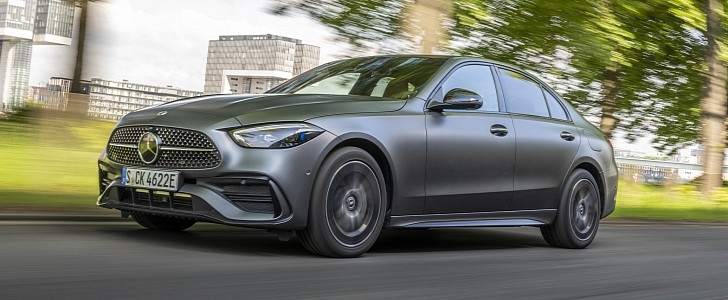Mercedes-Benz has expanded the new-gen C-Class family by launching the C 300 e. The plug-in hybrid is available in the Sedan and Estate versions of the car, with the former already up for grabs in Germany, and the latter arriving at dealers in December.
Pricing starts at €56,168 (equal to $65,305) for the C 300 e Sedan and €57,953 ($67,380) for the C 300 e Estate, and includes tax. Moreover, both models are eligible for an environmental bonus of €5,625 ($6,540) in their home market.
Power is supplied by a turbocharged 2.0-liter gasoline engine, making 204 ps (201 hp / 150 kW) and 320 Nm (236 lb-ft) of torque. An electric motor is also on deck, generating 129 ps (127 hp / 95 kW) and 440 Nm (325 lb-ft). The total system output is rated at 313 ps (309 hp / 230 kW) and 550 Nm (406 lb-ft), enabling a 0 to 100 kph (0-62 mph) acceleration in 6.1 seconds in the Sedan and 6.2 seconds in the Estate. Top speed stands at 245 and 240 kph (152-149 mph) respectively.
The electric driving mode is activated automatically, with the sensors of the car taking into account the navigation data, topography, traffic conditions, and speed limits along the planned route. Drivers can also engage it on their own at the flick of a switch.
One-pedal driving is available in the plug-in hybrid variants of the 2022 C-Class, which have an electric range of over 100 km (62 miles) in the WLTP cycle. Top speed in the zero-emission driving mode is capped at 140 kph (87 mph). With the battery charged, the average fuel consumption is 0.8-0.6 l/100 km (294-392 mpg US) in both versions.
Thanks to the positioning of the battery low under the trunk floor, there is no longer a step in the luggage compartment. The capacity has increased by 45 to 360 liters (1.6-12.7 cu-ft) in the Estate, compared to its predecessor, and with the rear seats folded down, it boasts 1,375 liters (48.6 cu-ft), 40 liters (1.4 cu-ft) more than before.
Power is supplied by a turbocharged 2.0-liter gasoline engine, making 204 ps (201 hp / 150 kW) and 320 Nm (236 lb-ft) of torque. An electric motor is also on deck, generating 129 ps (127 hp / 95 kW) and 440 Nm (325 lb-ft). The total system output is rated at 313 ps (309 hp / 230 kW) and 550 Nm (406 lb-ft), enabling a 0 to 100 kph (0-62 mph) acceleration in 6.1 seconds in the Sedan and 6.2 seconds in the Estate. Top speed stands at 245 and 240 kph (152-149 mph) respectively.
The electric driving mode is activated automatically, with the sensors of the car taking into account the navigation data, topography, traffic conditions, and speed limits along the planned route. Drivers can also engage it on their own at the flick of a switch.
One-pedal driving is available in the plug-in hybrid variants of the 2022 C-Class, which have an electric range of over 100 km (62 miles) in the WLTP cycle. Top speed in the zero-emission driving mode is capped at 140 kph (87 mph). With the battery charged, the average fuel consumption is 0.8-0.6 l/100 km (294-392 mpg US) in both versions.
Thanks to the positioning of the battery low under the trunk floor, there is no longer a step in the luggage compartment. The capacity has increased by 45 to 360 liters (1.6-12.7 cu-ft) in the Estate, compared to its predecessor, and with the rear seats folded down, it boasts 1,375 liters (48.6 cu-ft), 40 liters (1.4 cu-ft) more than before.














